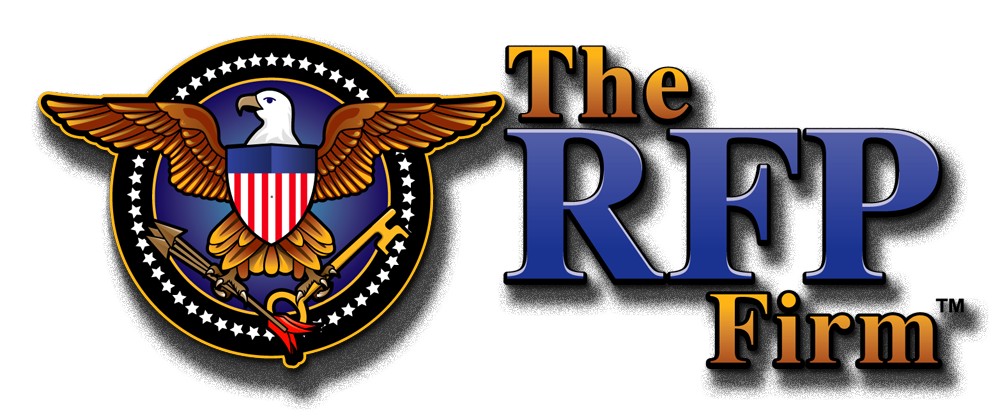Blog
Government & Commercial Proposal Writing Services
 The RFP Firm is expert at writing proposals in Response to Federal and State Government RFP Solicitations that will give you a Competitive Advantage over your competition.
The RFP Firm is expert at writing proposals in Response to Federal and State Government RFP Solicitations that will give you a Competitive Advantage over your competition.


Proposal Writing Services , RFP Proposal Consulting, Government RFP writing
Government RFP Proposal Writing Services
Government & Commercial Proposal Writing Services
 The RFP Firm is expert at writing proposals in Response to Federal and State Government RFP Solicitations that will give you a Competitive Advantage over your competition.
The RFP Firm is expert at writing proposals in Response to Federal and State Government RFP Solicitations that will give you a Competitive Advantage over your competition.

Issuing a formal RFP (Request for Proposal) is the primary method by which the government conducts business with third-party contractors. Understanding the RFP process is critical for ensuring that the time and effort you invest in this process is done correctly. Often, using the service of professional RFP writers is worth the investment. This is especially the case when you are a small business without the time, resources, and expertise to accomplish this on your own.
The RFP process is a formal one that is intended to level the playing field for those bidding so that the competition is fair, and each proposal is measured based on the same requested information and evaluation procedures. Sorting through the RFP and various attachments and forms can be a challenge and is often quite overwhelming.
The RFP itself will provide potential bidders with information about the agency, what it does, and the purpose of the proposed contract. Typically, they will include a detailed Performance Work Statement that includes a Scope of Work. This part of the document will let you know exactly what the performance requirements will be for providing the services under the contract. It may also identify what their expectations are, a timeline for delivering the required services, and the type of reporting necessary to support the project. It may also include the agency’s expectations for implementing the services and presenting the proposed pricing.
Another possible step in the RFP process is the issuance of an RFI (Request for Information) by which an Agency wants to get to know about the pool of potential contractors. Once the agency receives and reviews the RFIs, they can either incorporate feedback into a more formal RFP which is provided openly to the marketplace or send the RFP to only those whom they have identified as qualified based on the RFI feedback.
An alternative to the RFP process is an RFQ (Request for Quote) which usually would not require the expertise of a professional RFP writer. Rather than the bidder being asked to explain exactly how they will accomplish the work, the government specifies exactly how it should work. This leaves the primary response focused on a price quote along with proof that the bidders have the required experience.
While sorting through all of the detailed requirements of an RFP, there are a number of steps that are typically included. Each one of these steps will have specific requirements that must be responded to and followed to the letter. A proposal can easily get thrown out as noncompliant if even one small request is not fulfilled. Government contracts are usually quite complex because of all of the rules and regulations so it is imperative to respond to each RFP request regardless of whether it is a minor issue or has been duplicated somewhere else.
Proposal responses to RFPs are often broken up into separate volumes or sections which can include:
Often some of these areas are combined or missing entirely. In a federal government RFP, the information is laid out in alphabetical sections with the key two sections that should be reviewed prior to beginning the bid process being Section L: Instructions to Bidders and Section M: Evaluation Criteria. These two sections identify how the proposal should be organized, formatted, and the details of what needs to be included. Even so, throughout the RFP there you’ll find statements identifying additional information that must be included, so you still should go through all of the solicitation documents to ensure that you are 100% compliance with what is being requested.
Most RFPs are quite complex and should be systematically reviewed, outlined, and clear and concise narratives created for your response. Your internal “subject matter experts” should be the ones providing the information for each section. The narratives should describe how you will provide the services, what qualifications and experience you have as a company to perform those services, the key personnel who will be involved in managing and delivering those services, the qualifications of those key personnel, what type of quality assurance protocols you’ll use to ensure you achieve the requirements at the necessary level of quality, why you use that approach and those methods, your proposed price, and your pricing rationale. In addition, high quality references and past performance examples is critical along with proof of your company’s financial capacity to carry the contract through to completion.
One last item is to mitigate the risk of choosing your company over the competition. The key method for accomplishing this is to provide proofs that support the statements you make. For example, when you describe your approach and methodology, identify why you use that approach and give examples of past clients for whom you have successfully implemented those services. If your key personnel were responsible for those successful past projects, identify what their roles will be on this new contract.
The RFP process is designed to provide the confidence necessary to select your company from among the rest of the competing vendors.